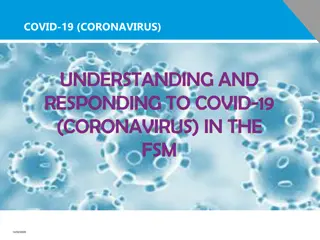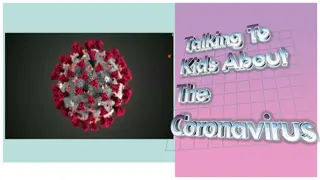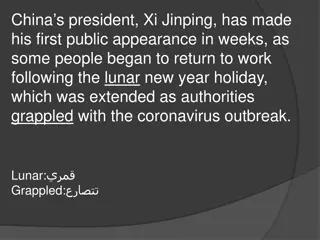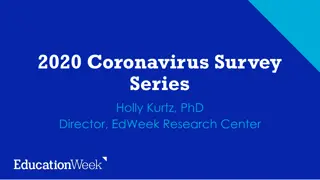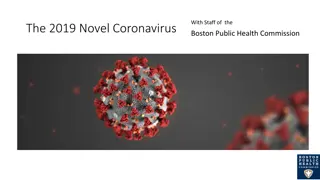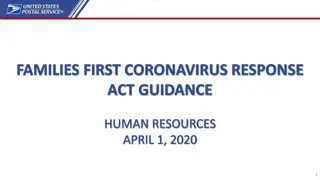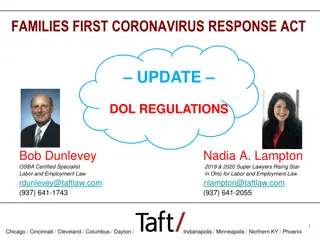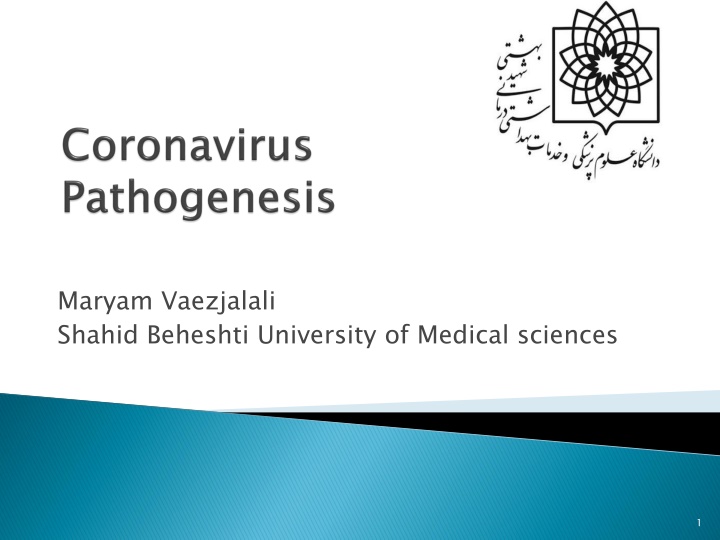
Human Coronaviruses: Insights and Origins
Discover the origins and characteristics of human coronaviruses, including how they differ in genetic variability and their potential zoonotic origins. Learn about the role of bats in the transmission of SARS-CoV and the mechanisms of lung infection by coronaviruses.
Download Presentation

Please find below an Image/Link to download the presentation.
The content on the website is provided AS IS for your information and personal use only. It may not be sold, licensed, or shared on other websites without obtaining consent from the author. If you encounter any issues during the download, it is possible that the publisher has removed the file from their server.
You are allowed to download the files provided on this website for personal or commercial use, subject to the condition that they are used lawfully. All files are the property of their respective owners.
The content on the website is provided AS IS for your information and personal use only. It may not be sold, licensed, or shared on other websites without obtaining consent from the author.
E N D
Presentation Transcript
Maryam Vaezjalali Shahid Beheshti University of Medical sciences 1
Prior to the SARS-CoV outbreak, coronaviruses were only thought to cause mild, self-limiting respiratory infections in humans. Two coronaviruses (HCoV-229E and HCoV-NL63) while the other two are -coronaviruses (HCoV-OC43 and HCoV-HKU1). HCoV-229E and HCoV-OC43 were isolated nearly 50 years ago while HCoV-NL63 and HCoV-HKU1 were only recently identified following the SARS-CoV outbreak. These viruses are endemic in the human populations, causing 15 30% of respiratory tract infections each year. of these human coronaviruses are - 5
One interesting aspect of these viruses is their differences in tolerance to genetic variability. HCoV-229E isolates from around the world have only minimal sequence divergence while HCoV-OC43 isolates from the same location but isolated in different years show significant genetic variability. This likely explains the inability of HCoV-229E to cross the species barrier to infect mice while HCoV- OC43 and the closely related bovine coronavirus, BCoV, are capable of infecting mice and several ruminant species. 6
It is widely accepted that SARS-CoV originated in bats as a large number of Chinese horseshoe bats contain sequences of SARS-related CoVs and contain serologic evidence for a prior infection with a related CoV. In fact, two novel bat SARS-related CoVs were recently identified that are more similar to SARS-CoV than any other virus identified to date. They were also found to use the same receptor as the human virus, angiotensin converting enzyme 2 (ACE2), providing further evidence that SARS-CoV originated in bats. 7
SARS-CoV primarily infects epithelial cells within the lung. The virus is capable of entering macrophages and dendritic cells but only leads to an abortive infection. Despite this, infection of these cell types may be important in inducing pro-inflammatory cytokines that may contribute to disease. In fact, many cytokines and chemokines are produced by these cell types and are elevated in the serum of SARS-CoV infected patients. The exact mechanism of lung injury and cause of severe disease in humans remains undetermined. 8
MERS-CoV is a group 2c -coronavirus highly related to two previously identified bat coronaviruses, HKU4 and HKU5 MERS-CoV utilizes Dipeptidyl peptidase 4 (DPP4) as its receptor. The virus is only able to use the receptor from certain species such as bats, humans, camels, rabbits, and horses to establish infection. 9
Host factors They cause more severe disease in neonates, the elderly, and in individuals with underlying illnesses, with a greater incidence of lower respiratory tract infection in these populations. the propensity of these viruses to jump between species, to establish infection in a new host As bats seem to be a significant reservoir for these viruses, it will be interesting to determine how they seem to avoid clinically evident disease and become persistently infected host immunopoathological response 10
Viral factors Viral structural proteins E protein (ion channel) Viral non structural proteins Nsp1,Nsp15 Immune evasion 11
To test the contribution of E protein IC activity in mouse-adapted SARS-CoVs, each containing one suppressed ion conductivity, were engineered. virus single pathogenesis, amino two recombinant mutation acid that Interestingly, displaying E protein IC activity, either with the wild-type E protein sequence or with the revertants that restored ion transport, rapidly lost weight and died. In contrast, mice infected with mutants lacking IC activity, which did not incorporate mutations within E gene during the experiment, recovered from disease and most survived. Knocking down E protein IC activity did not significantly affect virus growth in accumulation, the major determinant of acute respiratory distress syndrome (ARDS) leading to death. mice infected with viruses infected mice but decreased edema Levels of inflammasome-activated IL-1 were reduced in the lung airways of the animals infected with viruses lacking E protein IC activity, indicating that E protein IC function is required Reduction of IL-1 was accompanied by diminished amounts of TNF and IL-6 in the absence of E protein ion conductivity. All these key cytokines promote the progression of lung damage and ARDS pathology. In conclusion, E protein determinant for SARS-CoV virulence. for inflammasome activation. Nieto-Torres JL, DeDiego ML, Verdi -B guena C, Jimenez-Guarde o JM, Regla-Nava JA, et al. (2014) Severe Acute Respiratory Syndrome Coronavirus Envelope Protein Ion Channel Activity Promotes Virus Fitness and Pathogenesis. PLOS Pathogens 10(5): e1004077. IC activity represents a new 13
The replication of mutant virus, Covs-nsp1, was similar to wild-type Covs in cultured cells, including primary professional antigen-presenting cells, such as dendritic cells and macrophages, but its growth was severely attenuated in vivo, implying that Corona nsp1 is a major virulence factor. 17
block host gene expression including the innate immune response genes like type I IFN, ISG15 and ISG56, by inhibiting host protein synthesis and promoting the degradation of host mRNAs in SARS-CoV infected cells. 1. In addition, it also highlights functionally significant correlations between the nsp1of CoVs belonging to different genera, despite the lack of obvious primary sequence homology with each other, suggesting their evolutionary relatedness and role in the adaptation of CoVs to different host species. 2. 19
Coronavirus nonstructural protein 15 mediates evasion of dsRNA sensors and limits apoptosis in macrophages Xufang Deng, Matthew Hackbart, Robert C. Mettelman, Amornrat O Brien, Anna M. Mielech, Guanghui Yi, C. Cheng Kao, and Susan C. Baker. PNAS May 23, 2017 114 (21) E4251- E4260; first published May 8, 2017 https://doi.org/10.1073/pnas.1618310114 Macrophages are immune cells equipped with multiple double-stranded RNA (dsRNA) sensors designed to detect viral infection and amplify innate coronaviruses macrophages without activating dsRNA sensors. Here we present a function of murine coronavirus nonstructural protein 15 in preventing detection of viral dsRNA by host sensors. We show that coronaviruses expressing a mutant form of nonstructural protein 15 allow for activation of dsRNA sensors, resulting in an early induction of interferon, rapid apoptosis of macrophages, and a protective immune response in mice. Identifying the strategies used by viruses to evade detection provides us with new approaches for generating vaccines responses and protective immunity. antiviral immunity. can However, and many infect propagate in that elicit robust innate immune 20
The S protein mediates attachment of the virus to the host cell surface receptors and subsequent fusion between the viral and host cell membranes to facilitate viral entry into the host cell. In some CoVs, the expression of S at the cell membrane can also mediate cell-cell fusion between infected and adjacent, uninfected cells. This formation of giant, multinucleated cells, or syncytia, has been proposed as a strategy to allow direct spreading of the virus between cells, subverting virus-neutralising antibodies. Schoeman, Coronavirus envelope protein: current knowledge. Virol J 16, 69 (2019). https://doi.org/10.1186/s12985-019- 1182-0 D., Fielding, B.C. 21


